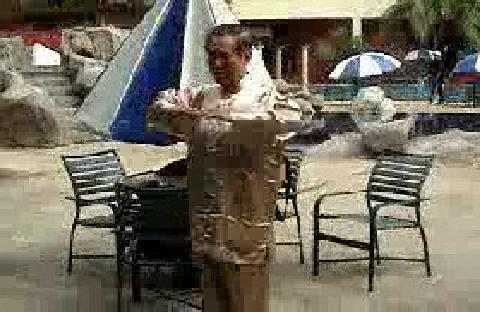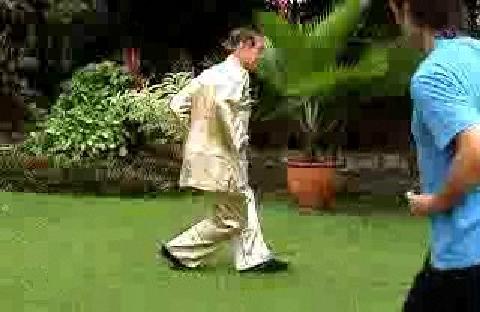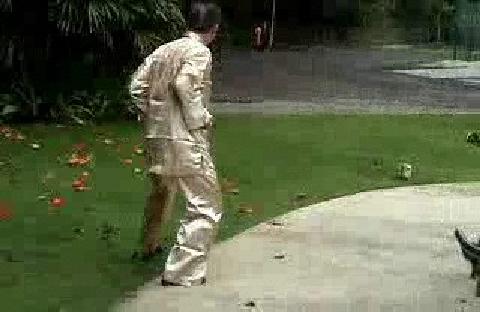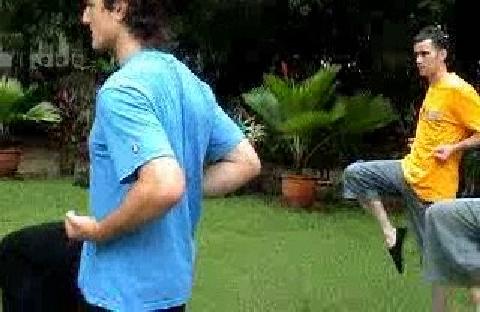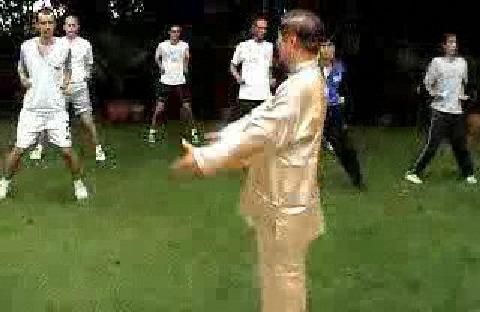STANCES: THE FOUNDATION FOR INTERNAL FORCE AND COMBAT EFFICIENCY
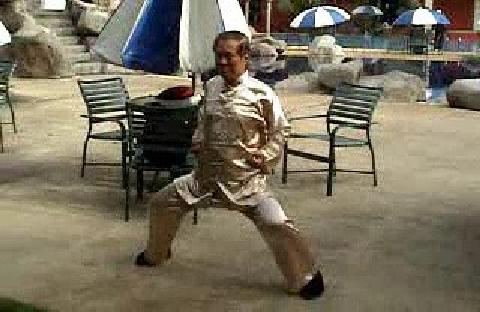 The Horse-Riding Stance
The Horse-Riding Stance
All great masters in the past emphasized the importance of stance training. There are stories describing kungfu practitioners in the past practicing stances for many months, or even years, before they were taught any kungfu techniques.
Why is stance training so very important? It is because it forms the foundation of kungfu. Although many people have heard of this statement, not many actually know what this means. Stance training develops internal force, and the use of stances enhance combat efficiency. Ironically, many students and some masters today discard stances for bouncing about.
There are some secrets of stance training. The biggest mistake many people make is to treat stance training as an endurance test. Stance training should be performed as a relaxation exercise.
Stance training is not a physical exercise where you toughen your muscles. It is a training of energy and mind. Hence, to be relaxed is essential. The form and nature of the stances are such that cosmic energy is focused and accumulated at the dan tian thereby developing internal force, and the mind is calm and clear thereby attaining mental freshness. Why stances enhance combat efficiency will be obvious in later video series on combat application.
Bringing chi to dan tian is a very important skill that is frequently used at the beginning as well as the end of training sessions, but not many people know its significance, and less people can do it effectively. Depending on your objectives, you may let the ch focus at the dan tian or let it flow harmoniously.
There are some secrets about the Horse-Riding Stance. Note the pyramid shape of the stance which allows cosmic energy to focus at the dan tian as well as flow down the feet into the ground.
Our Bow-Arrow Stance is different from that performed by most other schools. Our feet are in line with the toes of both feet hooked inward at about 45 degrees. The body faces in front squarely and the front knee is bent forward, not sideways, but it should not extend beyond the front toes. Records show that our Bow-Arrow Stance is similar to that performed by past masters.
Less than 5 percent of the body weight is on the front leg. The body is not vertical but slanting slightly forward to compensate for the different distribution of the body weight on the legs, so that the focus is naturally at the dan tian.
The Unicorn Stance is very versatile. Sit backward so that the two knees are together, with the back knee tugged at the back of the front knee. Raise the back heel. When the stance is used in transition, it is usually called the Unicorn Step.
The Four-Six Stance has a few different names. It is also called the Stream-Character Stance as it resembles the Chinese character for “stream”. It is called the Triangle Stance too as the base makes a triangle. It is also called the Three-Body Stance, especially in Hsing Yi Kungfu and Pakua Kungfu, because the three aspects of the body, namely feet, trunk and hands, should be in harmony.
The raised knee should be pointing upwards and the raised toes pointing downwards. Take care not to make a common mistake of leaning your body backwards. When you body is upright and relaxed, your chi will naturally focus at your dan tian, and you can remain stable easily.
When the form of this stance is correct and you are relaxed, chi flowing in from the Cosmos will naturally accumulate at your dan tian as well as root you to the ground. This is the secret why practicing this stance (as well as other stances) develops internal force. In some schools, the knees are hooked in tightly, but in our school the knees are only slightly hooked in and are relaxed.
 The Great Secret of Stance Training
The Great Secret of Stance Training
There are some great secret of stance training. There are only two steps. One, get the form correct. Two, follow the three golden rules, which are relax, relax and relax.
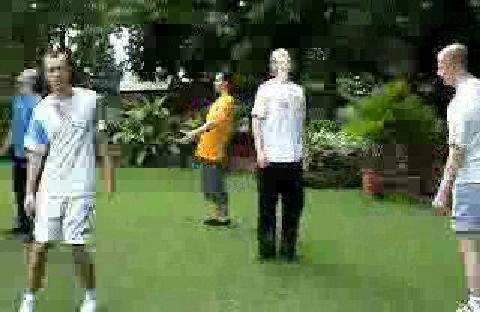 Flowing Breeze Swaying Willows
Flowing Breeze Swaying Willows
After remaining at the stances for some time, the participants go into a gentle chi flow, poetically described as “flowing breeze swaying willows”. Without this chi flow, much of the bendfit from stance training would be lost. (The background noise is due to children playing in a nearby pool. This is a bonus. If participants can enter “silence” despite the noise, they would do better in ideal conditions.)
Stances -- Foundation for Internal Force and Combat Efficiency from Wong Kiew Kit on Vimeo.
1. Stances: the Foundation for Internal Force and Combat Efficiency
2. Footwork Secrets for Health, Efficiency and Elegance
3. Moving into a Same Direction using Different Ways to Gain Advantages
4. Picture-Perfect Forms and Flowing Movements
5. From Random Fighting to Patterns, and from Patterns to Sequences and Sets
6. One-Step Sparring to Develop Combat Skills
7. From Pre-Arranged Sparring to Guided Sparring
8. Using Techniques and Tactics in Sparring
9. The Five Basic Kicks
10. The Secrets of Side Kicks and Continuous Cannons
11. How You may Defeat Opponents Experienced in Random Free Sparring
12. How Would a Fragile Girl Counter a Powerful Sweeping Kick from a Muay Thai Fighter?
13. Shaolin Felling Techniques and their Defences
14. Safety First Before Executing Felling Techniques
15. From Combat Sequences to Free Sparring
16. Sixteen Combat Sequences and Five Kungfu Sets
17. Surprise your Attacker with a Counter-Attack
18. Working out Ways to Fight a Boxer
19. Effective Tactics and Techniques against Boxers
20. From Gross Outline to Fine Details
21. Exploiting Advantage to Clinch Victory
22. Variety of Kungfu Techniques against Boxers
23. Analysis of Techniques Used against Boxers
24. Using Shaolin Kunfu against Boxing in Free Sparring
25. Effective Shaolin Tactics and Techniques against Kick-Boxing
26. Shaolin Kungfu against Kick-Boxing in Free Sparring
27. How to Handle a Karate Exponent
28. How to Handle a Taekwondo Exponent
29. How to Handle a Wrestling Exponent
30. Understanding the Typical Attacks of Muay Thai Fighters
31. Grandmaster Ho's Secrets in Countering Muay Thai Fighters
32. First Avoid Defeat, Then Secure Victory
33. Counteroing the Elbow and Knee Attacks of Muay Thai Fighters

